Grandstream IP Phone Supports Zero Touch Provisioning and Holistic Device Management
By Brad (Biju) Oommen
Originally published in MSP TODAY
July 11, 2019
Unified Communications as a Service (UCaaS) and Contact Center as a Service (CCaaS) providers can derive better business outcomes if devices like IP phones can be easily mass-deployed and managed using features from the cloud, such as zero touch provisioning and holistic device management. Zero touch provisioning essentially means the device delivered by the service provider works right out of the box with minimal effort. Holistic device management facilitates access and management across multiple SIP Server accounts and devices, real-time monitoring/alerting, device diagnostics, task scheduling/tracking and debugging activities like network captures and system logs. The above-mentioned features can help you oversee and manage device portfolios from the cloud.
During mass deployments, our stated objectives are ease of provisioning and continuous device management during the various phases of the device lifecycle. This allows us to drive down both CapEx and OpEx and expand the market reach of the services. One such solution that can meet these objectives is the Grandstream Networks GRP series of carrier-grade IP phones, which can be easily managed with the Grandstream Device Management System (GDMS), a cloud-based device provisioning and management solution. Grandstream offers unified firmware and configuration template across the GRP series, which translates to a firmware image that works across all GRP series devices while offering faster bug fixes and quicker upgrades.
Our discussion will primarily focus on the Grandstream Networks GRP2614 (Fig. A above) and GDMS (Fig. B).
.PNG)
The Grandstream Networks GRP2614 carrier-grade IP phone supports:
- Feature keys/SIP accounts: Four line keys/eight multi-purpose keys, extension keys with dual-color LED, four SIP accounts
- Graphic display: Dual screens, including a 2.8-inch (320x240) TFT color LCD and a 2.4-inch additional screen dedicated to up to 24 multi-purpose keys
- Two auto-sensing gigabit Ethernet ports: PC port/LAN port with PoE (802.3af)
- Dual-band WiFi 802.11 a/b/g/n/ac (2.4Ghz & 5Ghz) and Bluetooth ver. 5.0
- HD audio: handset and full-duplex hands-free speakerphone with support for wideband audio Voice codecs: G.711μ/a-law, G7.29A/B, G.726, G.722(wide-band),G723,iLBC, OPUS
- QoS: Layer 2 (802.1Q, 802.1p) and Layer 3 (ToS, DiffServ, MPLS) QoS
- Provisioning: Mass provisioning using GDMS/TR-069 or AES encrypted XML configuration
- Firmware upgrade using FTP/TFTP/HTTP/HTTPS and Dual-image firmware (you can store two copies of firmware on flash), secure boot and encrypted data storage
- Auxiliary port-RJ9 headset jack
- For easy logo customization, face plates are swappable.
Grandstream Networks GDMS supports:
- Authentication and security features including SN and MAC address authentication.
- Device information encrypted and stored so it cannot be illegitimately accessed.
- Two-way certificate verification between the devices and the GDMS platform.
- End-to-end TLS encryption to ensure data security.
- SHA-256 algorithm is used for account password encryption.
Functions such as account management, device configuration/management/monitoring, firmware upgrade, task management, batch configuration and management by models, sites and groups etc.
We will now proceed with the functional and interoperability testing of the GRP2614 along with the GDMS Beta version.
FUNCTIONAL TESTING
The test setup consisted of the Grandstream Networks GRP2614 carrier grade IP phone running software version 1.0.0.31, along with the following devices and systems (Please refer to Fig. C):
- Public SIP trunk services/UCaaS.
- Patton Networks Virtual SmartNode (vSN) running software version Trinity 3.15.3-19061 on Oracle VM VirtualBox hypervisor version 6.0.8. It provides SIP registrar services and SIP demarcation from the public SIP trunk/UCaaS provider in the cloud, while maintaining interoperability and interconnectivity.
- Grandstream Device Management System (GDMS) version 1.0.0.42 (Beta version used for testing). Cloud-based management system for Grandstream products including the GRP2614.
- Microsemi PDS-208G Digital Ceiling PoE switch-software release version 2.53 for network connectivity and PoE delivery.
- Grandstream Networks GWN7600 802.11ac Wave-2 WiFi access point running software version 1.0.9.13
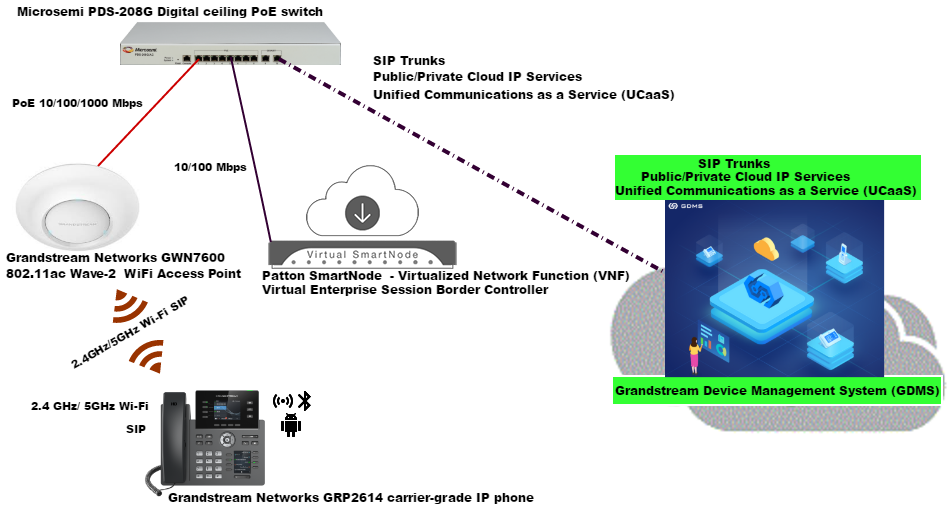
In this test setup, the Patton networks Virtual SmartNode (vSN) as a Virtual Network Function (VNF) Session Border Controller (SBC), provided SIP registrar services and SIP demarcation from the public SIP trunk/UCaaS provider in the cloud, while maintaining interoperability and interconnectivity. Powered up the GRP2614, logged in using the easy and intuitive web GUI for the initial provisioning and management as shown in Fig.D. It presented us with tabular options such as STATUS, ACCOUNTS, SETTINGS, NETWORK, MAINTENANCE etc.
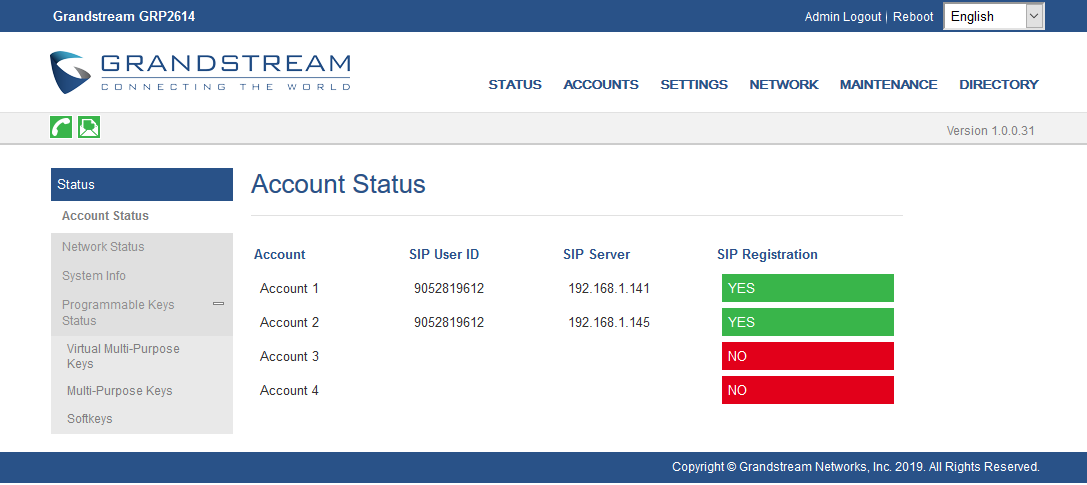
We configured/checked the values relevant for our testing by clicking/navigating and selecting appropriate values for:
- Accounts > For Account 1 and Account 2
- General Settings > Account Active: Yes, Account Name, SIP Server, Secondary SIP Server, Outbound Proxy, Backup Outbound Proxy, SIP User ID, Authenticate ID, Authenticate Password, Name.
- Audio Settings: Selected Preferred Vocoder choice 1… choice 8.
- Settings > Call Features > Click-To-Dial Feature: Enabled.
- Network > Basic Settings > Internet Protocol = Both, prefer IPv4, IPv4 Address = Static, IPv4 Address, Subnet Mask, Gateway, DNS Server 1, DNS Server 2, Preferred DNS Server etc. Bluetooth Settings > Bluetooth Power = ON, Handsfree Mode = ON, Bluetooth Name etc.
- WiFi Settings > Enable/Disable WiFi = Yes, Country, Access Point 1 > SSID, Password, Security Type (Wi-Fi encryption type) etc.
We then proceeded with the onboarding of the GRP2614 to the GDMS cloud, to benefit from a centralized single portal interface that permitted full monitoring, maintenance and reporting during the entire lifecycle of the device. Logged in to GDMS in the cloud (Beta version). The GDMS web interface, shown in Fig. E, straight away presented us with the dashboard view.
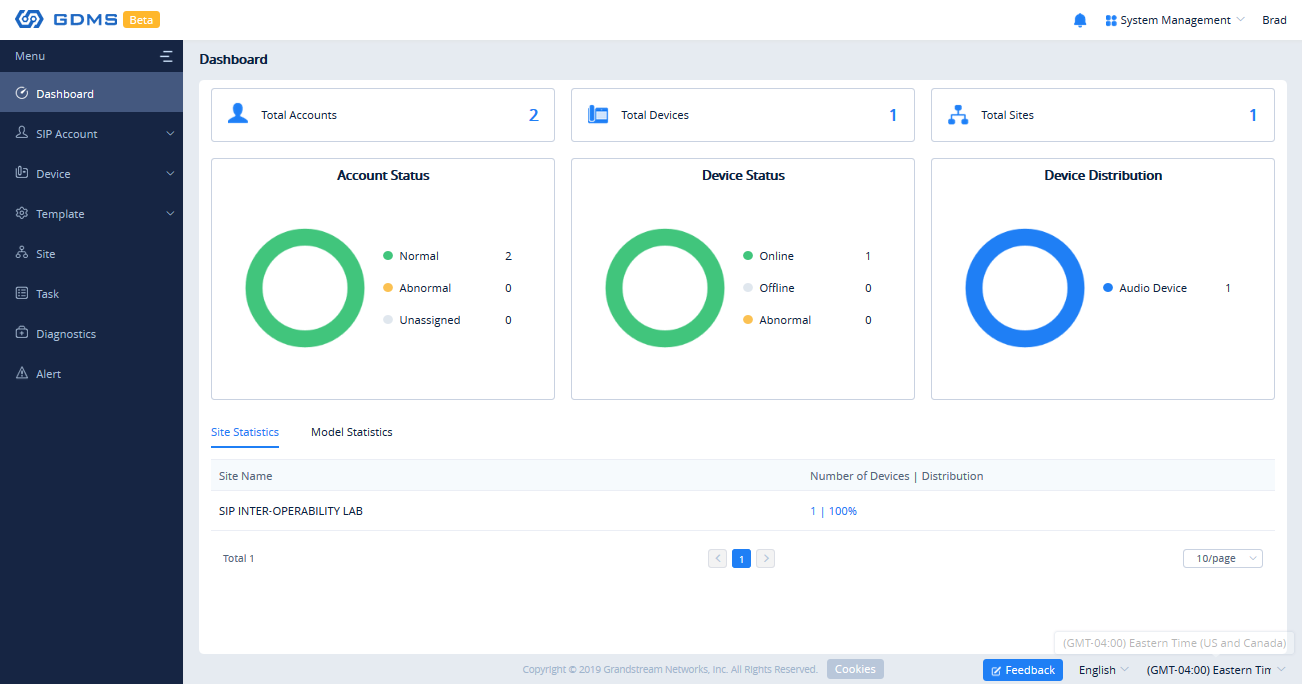
The dashboard easily provided rich insight by combining multiple views of data: Total Accounts, Total Devices, Total Sites, Site Statistics etc. For each of those items on the dashboard, we were able to drill down further for more actionable details and controls. You can access the GDMS and manage the GRP2614 from anywhere through a Web browser. Besides the dashboard on the main menu there is the SIP Account, Device, Template, Site, Task, Diagnostics, Alert. All are very clearly presented and intuitive to use.
Briefly, the onboarding process included the following: adding SIP accounts, SIP Servers, Device, Site etc. Clicking on-SIP Account > SIP Account > Add Account, configured applicable values for-Account Name, SIP Server, SIP User ID, SIP Authentication ID, SIP Authentication Password, Display Name, Assign Device- selected GRP2614, MAC, Account etc. (Fig. F)
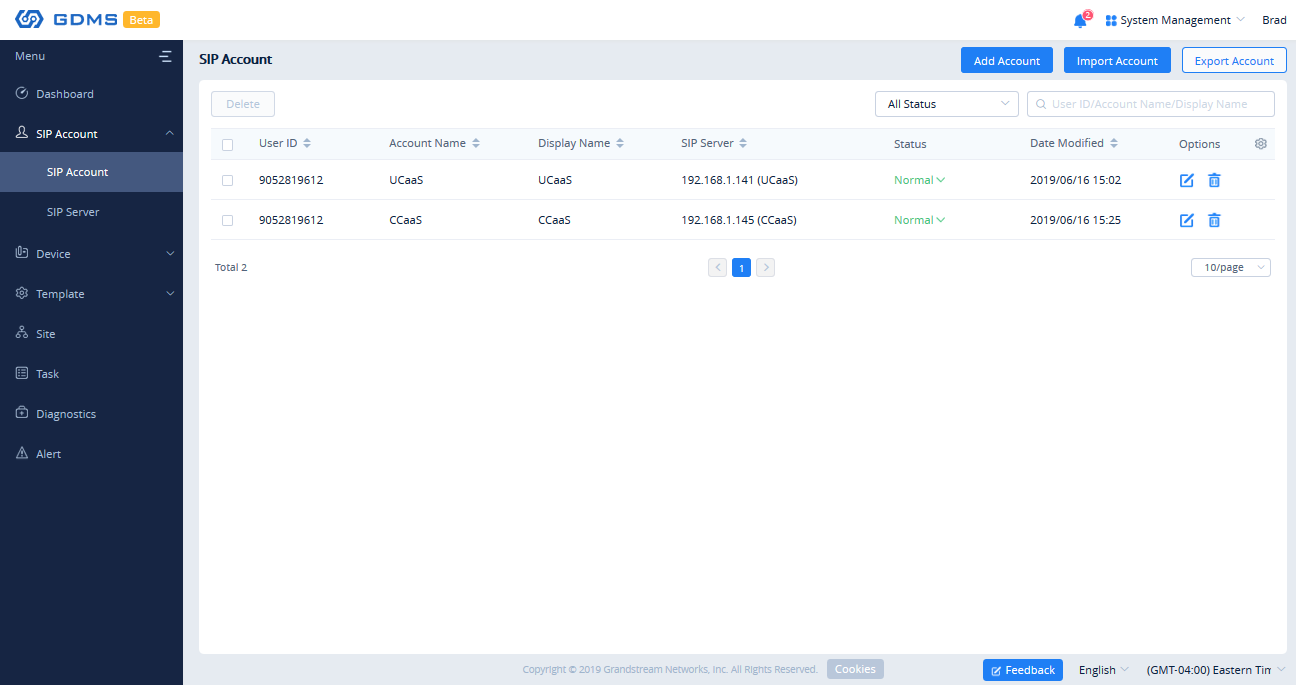
SIP Server > Add Server, entered values for Server Name, SIP Server, Outbound Proxy etc. (Fig. G)
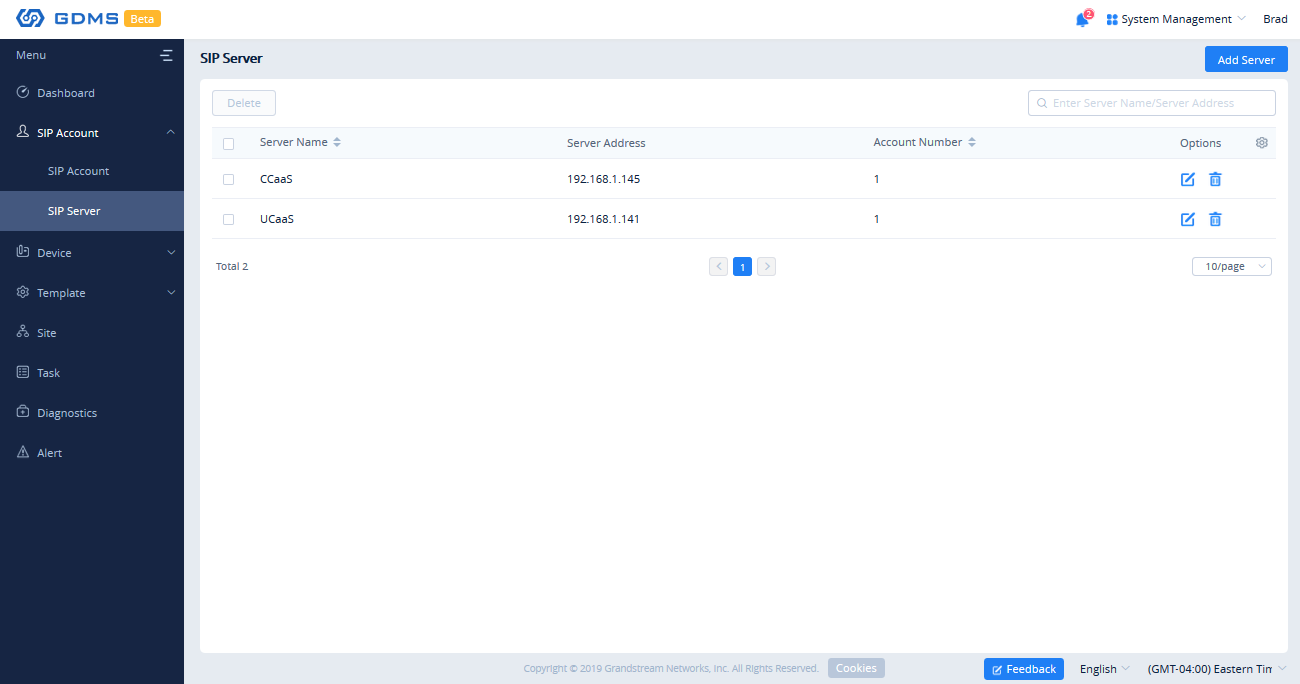
Device > Device List > Add Device, values for Device Name, MAC Address, S/N etc. (Fig. H)
Template > Add Model Template Name, Model, Auto provision Devices All Sites/Site, Description etc.
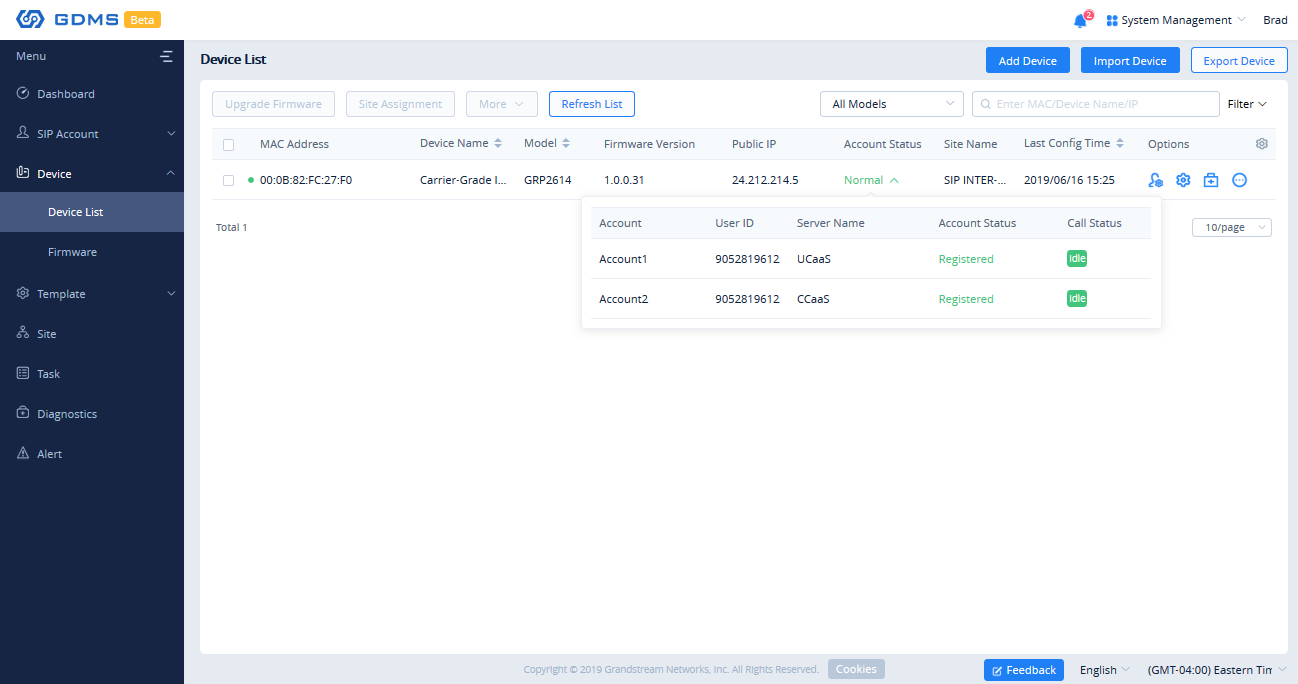
The configuration was easy and uncomplicated for our testing. We clicked on Task > Add Task, selected Task Name, Task Type (Reboot Device, Factory Reset, Upgrade Firmware, Update Config: Model etc.), Task Time (Immediate/Scheduled), Run Device (Select device/enter MAC Address).
Diagnostics allowed us to view useful information on the GRP2614, including System Information, Account Status, Start Device Diagnostics (Ping/Traceroute, Syslog Capture, Network Capture). Last, but not the least, we set up alerting, under Alert, e-mail notification settings/Message Notification Settings: Account Registration failed, Factory Reset, Task failures, Device Offline, Reboot Device. Overall, the configuration was easy and straightforward for our testing with the GDMS providing actionable insight on the deployed GRP2614.
From an administrator’s perspective, the whole setup was very streamlined, requiring just a few clicks on the relevant screens.
Using the GRP2614, we placed inbound and outbound calls successfully (Fig. I), using the multiple SIP accounts/SIP Servers via the Patton Virtual SmartNode as a Virtual Network Function Session Border Controller. The cloud-based GDMS provided all the necessary management and monitoring functions for the GRP2614.
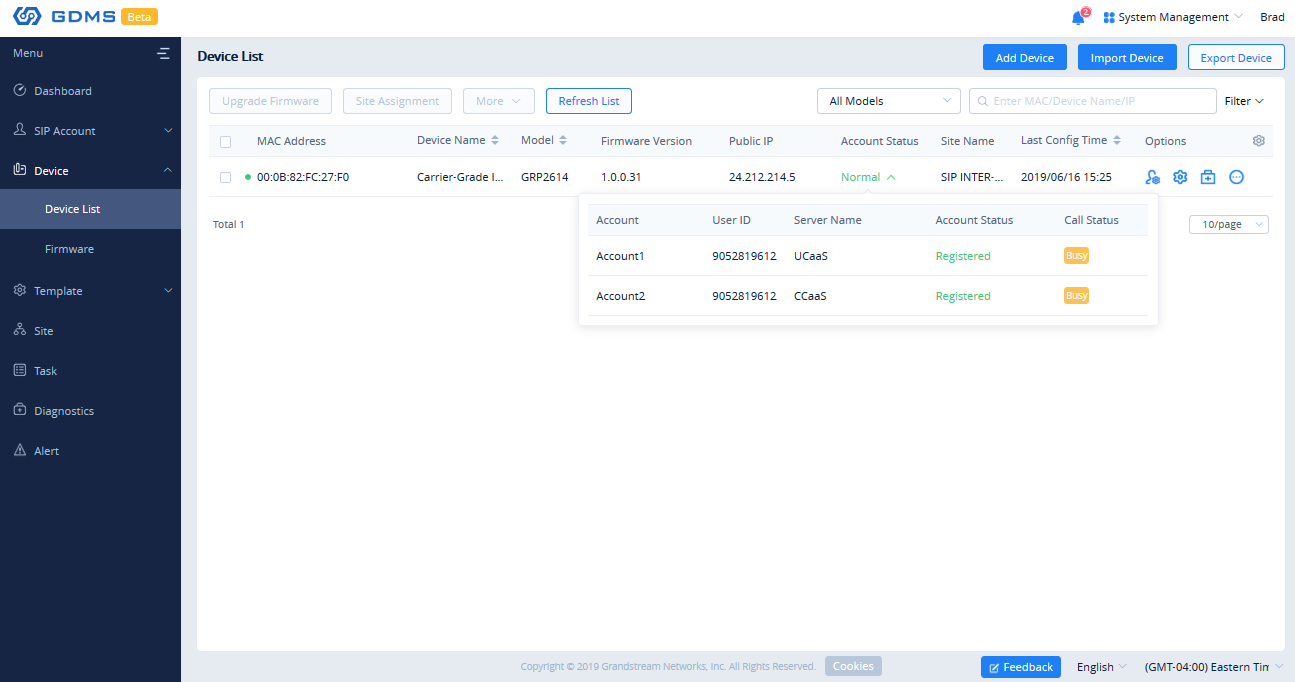
Grandstream Networks’ GRP2614, when combined with the GDMS, can be very productive and useful for service providers, as they can deploy the GRPs at multiple locations with agility, speed and consistency.
Conclusion
Grandstream’s GRP2614 a carrier-grade IP phone that is full-featured, easy to set up, use, manage and offers good voice quality. You can speed up mass deployments and reduce Total cost ownership (TCO) when the GRP2614 is combined with the cloud-based centrally managed GDMS, which offers configuration, management and monitoring of devices as well as the associated accounts.


Comments
Post a Comment